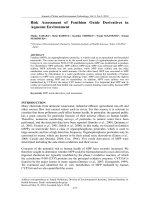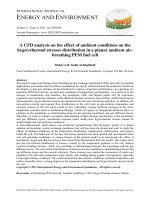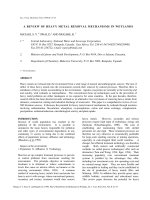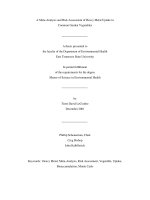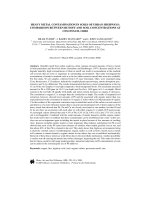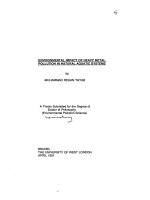A meta analysis and risk assessment of heavy metal uptake in common garden vegestable
Bạn đang xem bản rút gọn của tài liệu. Xem và tải ngay bản đầy đủ của tài liệu tại đây (191 KB, 64 trang )
A Meta-Analysis and Risk Assessment of Heavy Metal Uptake in
Common Garden Vegetables
A thesis presented to
the faculty of the Department of Environmental Health
East Tennessee State University
In partial fulfillment
of the requirements for the degree
Master of Science in Environmental Health
by
Trent David LeCoultre
December 2001
Phillip Scheuerman, Chair
Creg Bishop
John Kalbfleisch
Keywords: Heavy Metal, Meta-Analysis, Risk Assessment, Vegetable, Uptake,
Bioaccumulation, Monte Carlo
2
ABSTRACT
A Meta-Analysis and Risk Assessment of Heavy Metal Uptake in
Common Garden Vegetables
by
Trent David LeCoultre
Peer reviewed literature was searched to identify research pertaining to the uptake of heavy
metals (As, Cd, Pb, and Zn) by vegetables (cabbage, carrot, lettuce, and radish). The objectives
of this research were to 1) determine the relationship between heavy metal concentrations in the
soil and heavy metal concentrations in vegetables and 2) determine the level of risk associated
with exposure to heavy metals through ingestion of contaminated vegetables. Highly variable
estimates and biologically implausible regression equations resulted from this meta-analysis.
Exposure to arsenic through the ingestion of lettuce grown on contaminated soil significantly
increases cancer risk, especially in children. Highly variable hazard quotients prevent strong
statements concerning toxic effects from exposure to Pb, Cd, or Zn. A more in-depth meta-
analysis (multiple-regression and nonlinear curve-fitting) and an upgrade in data reporting
standards are recommended.
3
DEDICATION
This work is most sincerely dedicated to my wife, Amberly. Because of her unfaltering
love, devotion, and motivation, I have been able to find within myself the fortitude and
wherewithal to acheive my academic goals. Her ambition and drive inspire me. She is my
companion, my best friend, and my soul mate. A greater gift has no man.
4
ACKNOWLEDGEMENTS
I would like to thank the members of my thesis committee Dr. Phil Scheuerman, Dr. Creg
Bishop, and Dr. John Kalbfleisch for their participation in my research. I would also like to
thank the Environmental Health Departmental secretaries, Christy Hoffman and Sandy Peacock,
for going out of their way to help me during my time here.
A special thanks is extended to Gino Begliutti and Doug Dulaney for their comments and
advice during the writing of this thesis. Their support and genuine friendship are greatly
appreciated. Thanks also to Brian Evanshen and everyone else in the ‘zoo’ for the help and
encouragement they have provided.
Finally, I would like to express my sincere gratitude to my family. Without their
encouragement and loving support of my endeavors, academic or otherwise, I would not have
accomplished my goals. I will never forget the personal sacrifices they have made to ensure that
I succeed. I hope I never take them for granted and I pray that I’ve made them proud.
5
CONTENTS
Page
ABSTRACT 2
DEDICATION 3
ACKNOWLEDGEMENTS 4
LIST OF TABLES 7
Chapter
1. INTRODUCTION 8
Background 8
Objectives 9
2. LITERATURE REVIEW 10
Arsenic 10
Uses, Sources, Fate, and Transport 10
Toxicity 11
Cadmium 12
Uses, Sources, Fate, and Transport 12
Toxicity 14
Lead 15
Uses, Sources, Fate, and Transport 15
Toxicity 16
Zinc 17
Uses, Sources, Fate, and Transport 17
Toxicity 18
Risk Assessment 19
Meta-Analysis 21
3. RESEARCH DESIGN 24
Inclusion Criteria 24
Database Compilation 26
6
Meta-Analysis 26
Risk Assessment 27
4. RESULTS AND DISCUSSION 32
Meta-Analysis 43
Risk Assessment 46
5. CONCLUSIONS AND RECOMMENDATIONS 51
Conclusions 51
Recommendations 52
REFERENCES 53
APPENDICES 59
Appendix A: Meta-Analysis Data 59
Appendix B: Risk Assessment Data 61
VITA 64
7
LIST OF TABLES
Table Page
1. Data Evaluation Steps Outlined in the USEPAs Risk Assessment Guidance for Superfund
(RAGS) (EPA 1989) 20
2. Situations Where Meta-analysis May be Useful as Outlined by Blair et al. (1995) 22
3. Studies That Have Been Included Into the Meta-analysis 25
4. Mean Per Capita Intake Rates (As Consumed) for Vegetables (EPA 1997) 27
5. Pooled Equations from the Regression of the Dependant Plant-Metal Concentration and the
Independent Soil-Metal Concentration and Associated R
2
-Values for Each Plant-Metal
Group. 33
6. Cancer Risk for Populations Exposed to Arsenic Contaminated Vegetables 34
7. Noncancer Hazard Quotients for Children 1-6 Years Old Exposed to Heavy Metal
Contaminated Vegetables 36
8. Noncancer Hazard Quotients for Average Adults Exposed to Heavy Metal Contaminated
Vegetables 37
9. Noncancer Hazard Quotients for Adults 55+ Years Old Exposed to Heavy Metal
Contaminated Vegetables 38
10. Noncancer Hazard Quotients for Exposure to Lead Using a RfD of 0.05 mg/kg-day 41
11. Noncancer Hazard Quotients for Populations Exposed to Lead in Lettuce for Two Different
Reference Doses 42
12. Raw Data for Weighting and Combining Using Meta-analysis 59
13. R, R
2
, Slope and Y-intercept Values Combined From Like Plant-Metal Groups and the
Number of Studies in Each Group 60
14. Values Used in the Calculation of Cancer Risk for Populations Exposed to Arsenic 61
15. Values Used in the Calculation of Hazard Quotients for Populations Exposed to Cadmium
and Lead 62
16. Values Used to Calculate Hazard Quotients for Populations Exposed to Zinc 63
8
CHAPTER 1
INTRODUCTION
Background
Toxicity of ingested heavy metals has been an important human health issue for decades.
The prevalence of contamination from both natural and anthropogenic sources has increased
concern about the health effects of chronic low-level exposures. Many researchers have shown
that some common garden vegetables are capable of accumulating high levels of metals from the
soil (Garcia et al. 1981, Khan and Frankland 1983, Xiong 1998, Cobb et al. 2000). Certain
Brassica species (cabbage) are hyperaccumulators of heavy metals into the edible tissues of the
plant (Xiong 1998). This is an important exposure pathway for people who consume vegetables
grown in heavy metal contaminated soil.
Natural and anthropogenic sources of soil contamination are widespread and variable.
Heavy metals occur naturally in rocks. Arsenic is found in sulfide ores such as Arsenopyrite
(FeAsS), cadmium is associated with sphalerite, and lead is found in many ores and is the natural
byproduct of radioactive decay of uranium
206
and other elements (ATSDR 1999b).
Anthropogenic sources of heavy metal contaminants are more likely the cause of the higher more
toxic concentrations in soil. Sources may include mining and smelting of ores, electroplating
operations, fungicides and pesticides, sewage and sludge from treatment plants, and the burning
of fossil fuels (John and VanLaerhoven 1972; Woolson 1973; Boon and Soltanpour 1992; Cobb
et al. 2000).
Certain plants can accumulate heavy metals in their tissues. Uptake is generally
increased in plants that are grown in areas with increased soil concentrations. Many people
could be at risk of adverse health effects from consuming common garden vegetables cultivated
in contaminated soil. Often the condition of garden soil is unknown or undocumented; therefore,
exposure to toxic levels can occur. (Xu and Thornton 1985) suggest that there are health risks
from consuming vegetables with elevated heavy metal concentrations. The populations most
affected by heavy metal toxicity are pregnant women or very young children (Boon and
Soltanpour 1992). Neurological disorders, CNS destruction, and cancers of various body organs
are some of the reported effects of heavy metal poisoning (ATSDR 1994; ATSDR 1999a;
ATSDR 1999b; ATSDR 2000). Low birth weight and severe mental retardation of newborn
9
children have been reported in some cases where the pregnant mother ingested toxic amounts of
a heavy metal (Mahaffey et al. 1981).
Objectives
The objectives of this research were to 1) determine the relationship between heavy metal
concentrations in the soil and heavy metal concentrations in vegetables and 2) determine the
level of risk associated with exposure to heavy metals through ingestion of contaminated
vegetables.
10
CHAPTER 2
LITERATURE REVIEW
Arsenic
Uses, Sources, Fate, and Transport
Approximately 90% of all arsenic produced in the United States is used to preserve
lumber. Chromated copper arsenate (CCA) is the preservative used to retard the rotting and
deterioration of wood exposed to weathering and insects (ATSDR 2000). Arsenic has also been
used for decades as an ingredient in pesticides and fungicides. Arsenic acid (As
2
O
3
٠H
2
O) is
used as a weed killer and in leaf desiccation of cotton plants (Woolson 1973). Arsenic is also
used in the smelting of ores and in electroplating (Cobb et al. 2000). Atmospheric fallout from
smelting and other manufacturing processes can be a significant source of As in the environment.
Arsenic is typically immobile in agricultural soil and, therefore, accumulates in the upper
soil horizons (ATSDR 2000). Janssen et al. (1997) used a regression analysis of pH, organic
matter content, clay content, iron oxide content, aluminum oxide content, and cation exchange
capacity versus As mobility to determine how each parameter affected As mobility in soil
(Janssen et al. 1997). They found that iron oxide content was the only soil characteristic
significantly positively correlated with As mobility. Arsenic mobility is more dependant on
ligand exchange mechanisms, particularly with iron oxides, than the pH-dependant dissolution-
precipitation reactions that regulate the movement of most other metals in the soil (Darland and
Inskeep 1997; Jones et al. 1997). Darland and Inskeep (1997) found that arsenate (AsO
4
)
transport through sand containing free iron oxides was very slow at pH 4.5 and 6.5, and
significantly more rapid at pH 8.5. They suggested that liming soil to increase the pH and
promote metal precipitation to decrease metal mobility, may actually facilitate the movement of
As.
Arsenates (As(V)) are more toxic and more mobile in the soil than arsenites (As(III))
(McGeehan 1996). Some aquatic organisms and soil bacteria can reduce As(V) to As(III),
increasing its toxicity and its mobility in the soil (Honschopp et al. 1996; Turpeinen et al. 1999;
ATSDR 2000). Under reducing conditions, such as temporarily flooded or saturated soil,
inorganic arsenicals may be methylated to produce the less toxic organic forms, monomethyl
arsonic acid (MMA) or dimethyl arsinic acid (DMA) (Honschopp et al. 1996).
11
Toxicity
Inorganic arsenic is highly toxic, and acute exposures cause vomiting, diarrhea, and
gastrointestinal hemorrhage. Death can occur at doses that range from 22 to 121 mg As/kg of
body weight. For example, 2 people in a family of 8 died after 1 week of drinking water that
contained 110 ppm As (2 mg As/kg/day) (Armstrong et al. 1984). Death usually results from
fluid loss and circulatory collapse. Chronic, low-dose exposure causes several adverse health
effects. Cough, sputum, rhinorrhea, and sore throat have been reported by people exposed to
0.03-0.05 mg/kg/day. Because people in areas of Taiwan receive doses of 0.014-0.065
mg/kg/day in drinking water, “Blackfoot disease” is endemic. Blackfoot disease is decreased
circulation in the extremities, which leads to necrosis and gangrene. Although there are limited
data to support developmental toxicity of arsenic, Golub et al. (1998) used animal models to
show a dose-dependant increase in stillbirths and postnatal growth retardation in females
chronically exposed before and during pregnancy (Golub et al. 1998). Anemia and luecopoenia
have also been reported at acute, intermediate, and chronic exposure levels. Arsenic exposure
causes several dermal effects. Generalized hyperkeratosis and the formation of hyperkeratotic
warts and corns on the palms and the soles of the feet are caused by chronic arsenic ingestion.
Discoloration of the skin of the face, neck, and back also can occur. Squamous cell carcinomas
can form from hyperkeratotic warts and corns. Basal cell carcinomas are also caused by arsenic
exposure but they do not form from the warts or corns. Chronic low-level exposure also
increases the incidence of internal cancers. Cancers of the bladder, kidney, liver, lung, and
prostate have been documented in animal studies. The Department of Health and Human
Services (DHHS), the International Agency for Research on Cancer (IARC), the United States
Environmental Protection Agency (EPA), and the National Toxicology Program (NTP) have all
classified inorganic arsenic as a known human carcinogen (ATSDR 2000).
The EPA has determined that the reference dose (RfD) for inorganic arsenic is 0.0003 mg
As/kg/day (Anonymous2001b). This RfD is derived from the NOAEL of 0.009 mg As/L using
an uncertainty factor of 3. The NOAEL was established based on the occurrence of skin lesions
in humans exposed to As. Skin lesions were the most sensitive endpoint. Tseng et al. (1968)
conducted the principle study used to determine the NOAEL. The arithmetic mean of the
concentration of arsenic in the well water of the control group was used as the NOAEL. To
12
derive the RfD, the NOAEL (0.009 mg/L) was first converted to mg As/kg/day. Assumptions
used included consumption of 4.5L water/day, 55 kg body weight, and a food concentration of
0.002 mg As/day. The resulting NOAEL was 0.0008 mg As/kg/day. An uncertainty factor of 3
was used to account for limited data and the possible exclusion of sensitive individuals (ATSDR
2000).
Organic arsenicals are less toxic than the inorganic forms. The 2 primary forms of
organic arsenic are monomethyl arsonic acid (MMA) and dimethyl arsinic acid (DMA). MMA
and DMA are primarily used as agricultural pesticides. Data about the toxicity of organic forms
of arsenic are limited; however, based on available data, organic arsenic is not toxic (ATSDR
2000).
Cadmium
Uses, Sources, Fate, and Transport
Although cadmium is a naturally occurring element, it is rarely found as a pure metal in
nature. It is generally associated with oxygen, chlorides, sulfates, and sulfides. Cadmium is
often a byproduct of the extraction of Pb, Zn, and Cu from their respective ores (ATSDR 1999a).
Carbonaceous shale, coal, and other fossil fuels are also sources of Cd. Volcanism is the largest
natural source of Cd (ATSDR 1999a). Anthropogenic sources of Cd in the soil and groundwater
include the use of commercially available fertilizers and the disposal of sewage sludges as soil
amendments (Baker et al. 1979; Garcia et al. 1979; Kosla 1986; Peles et al. 1998; Gallardo-Lara
et al. 1999).
Cadmium can accumulate in high concentrations in soils. John et al. (1972) report a Cd
concentration of 95 ppm in a sample collected near a battery smelter near Vancouver, BC,
Canada. Cadmium is recalcitrant in the soil profile, particularly in the surface horizons (John et
al. 1972; Khan and Frankland 1983). Most soil profiles have an A horizon, which is primarily
topsoil composed of decaying organic matter such as leaves and grass, and a B horizon, which is
composed of smaller clay-sized particles. In general, heavy metal concentrations are higher in
the B horizons than in the A horizons (Lee et al. 1997). Heavy metals tend to accumulate in the
clay fraction of most soil profiles (Boon et al. 1992; Lee et al. 1997). Boon et al. (1992)
concluded that the concentration of heavy metals in soil is dependant on clay content because
clay-sized particles have a large number of ionic binding sites due to the higher amount of
13
surface area. This results in the immobilization of heavy metals, and there is very little leaching
through the soil profile (Khan and Frankland 1983). Immobilization can increase the Cd
concentration of the soil and ultimately lead to the increased toxicity of the contaminated soil.
Higher soil Cd concentrations can result in higher levels of uptake by plants (John et al. 1972).
However, specific soil properties can have a significant effect on the amount of heavy metal
assimilated by the plant (John and VanLaerhoven 1972; Peles et al. 1998).
Increased levels of Ca
2+
can decrease the amount of Cd that is assimilated by plants
(Larlson et al. 2000). Because of their similar size, Ca(II) is almost indistinguishable from
Cd(II) (Ochiai 1995). A higher affinity for the essential trace metal Ca results in the decreased
uptake of Cd into the plant. A similar relationship exists between P and Cd. John et al. (1972)
showed that the addition of 1000 ppm of phosphorus to a Cd contaminated soil deceased
the concentration of Cd 43% in the roots of oats. Trace metal deficiencies in plants have
been associated with increases in heavy metal uptake (Khan and Frankland 1983).
Soil pH significantly influences heavy metal concentrations in both soil and plant tissues.
The effect of soil pH on mobility of heavy metals is a well-researched topic (Cataldo et al. 1981;
Chen et al. 1997; Peles et al. 1998; Li and Wu 1999). As the soil pH decreases, metals are
desorbed from organic and clay particles, enter the soil solution and, become more mobile (Li
and Wu 1999). When the pH is higher (i.e., >7), metals remain adsorbed and what metals in
solution precipitate out in the form of salts (Chen et al. 1997). Variability in pH also affects the
amount of Cd assimilated by the plant. John and VanLaerhoven (1972) showed that higher pH
resulted in lower Cd uptake. Peles et al. (1998) concluded that the addition of lime to
contaminated soils (essentially increasing the pH) decreased the uptake of heavy metals. In
unlimed soils Ambrosia trifida accumulated 13.6 µg Cd g
-1
of tissue and in limed soils A.trifida
accumulated 2.5 µg Cd g
-1
of tissue.
Khan and Frankland (1983) reported that extremely high concentrations (180 µg g
-1
) of
Cd in soil adversely affected plant development. In their research, radish plants were grown on
soils contaminated with Cd and Pb. Within 3 weeks of planting, all plants that were grown in
soil contaminated with 1000 µg Cd g
-1
were dead. The concentrations of Cd in the soil that
produced a 50% inhibition in growth were higher at the seedling stage than at the edible stage.
John et al. (1972) also showed that plant size and yield were reduced when 50 mg Cd (dosed as
CdCl
2
) was added to 500g of soil. In both studies, chlorosis of the leaves was reported. Khan
14
and Frankland (1983) suggest additive effects from the application of Cd and Pb at the same
time. They document a considerable reduction in growth when Cd was added at 50 µg g
-1
and
Pb was added at 1000 µg g
-1
(Khan and Frankland 1983).
Toxicity
The Agency for Toxic Substances and Disease Registry (ATSDR) reports that the
average American ingests about 30 µg Cd/day (ATSDR 1999a). However, only about one tenth
of this amount is actually absorbed into the tissues. Intake of Cd can double if one smokes
cigarettes because each cigarette contains about 2 µg Cd. Acute doses (10-30 mg/kg-day) of
cadmium can cause severe gastrointestinal irritation, vomiting, diarrhea, and excessive
salivation, and doses of 25 mg CdI
2
/kg body weight can cause death.
Low-level chronic exposure to Cd can cause adverse health effects including
gastrointestinal, hematological, musculoskeletal, renal, neurological, and reproductive effects.
The main target organ for Cd following chronic oral exposure is the kidney (ATSDR 1999a).
Because cadmium tends to accumulate in the kidneys, the EPA has based the RfD for cadmium
on the concentration of the metal in the human renal cortex (EPA 1994a). The highest Cd level
in the renal cortex that does not cause significant proteinuria is 200µg Cd/g (EPA 1994a;
ATSDR 1999a). A toxicokinetic model was used to determine the no-observable-adverse-effect-
level (NOAEL) dose that would result in a renal cortex concentration of 200 µg Cd/g. To use the
model, it was assumed that 0.01% of the daily Cd body burden is excreted in the urine or feces
and that 2.5% of the Cd in food and 5% of the Cd in water are actually absorbed into the body
tissues. Based on these assumptions, the model estimate of the NOAEL is 0.01 mg Cd/g for food
and 0.005 mg Cd/g for water. The RfD is determined using the NOAEL and an uncertainty
factor of 10. The uncertainty factor is used to take into account biological variability. EPA has
established RfDs for Cd of 0.001 mg Cd/kg/day for food and 0.0005 mg Cd/kg/day for water.
These amounts represent an estimated daily oral exposure that is likely not to cause adverse
health effects (EPA 1994a).
The ATSDR concludes that there is insufficient evidence to determine whether oral
exposure to Cd increases the risk for cancer. However, the United States Department of Health
and Human Services (DHHS) has stated that cadmium compounds may be carcinogenic
(ATSDR 1999a). The International Agency for the Research on Cancer (IARC) has classified
15
Cd and Cd salts as possible human carcinogens. This classification is based on human lung
cancer data from occupational inhalation (ATSDR 1999a).
Lead
Uses, Sources, Fate, and Transport
Lead is a naturally occurring heavy metal. It is seldom found in its elemental form;
however, it is part of several ores including its own (galena, PbS). Pb is also a product of the
radioactive decay of uranium
206
, thorium
208
, and actinium
207
(Sax and Lewis Sr. 1987). Pb has
many industrial and commercial uses. It is used in the production of ammunition, as solder, in
ceramic glass, and the production of batteries (ATSDR 1999b). Other sources of Pb in the
environment include automobile exhaust, industrial wastewater, wastewater sludge, and
pesticides (Balba et al. 1991). Because of its high toxicity, the use of lead in some products has
been discontinued. Lead is no longer used in house paint because of the concern about the toxic
effects of the accidental ingestion of paint chips or the inhalation of aerosolized lead from
decaying paint. In 1991, the amount of Pb was greatly reduced in gasoline (Anonymous2001a).
Most of the environmental lead contamination comes either from landfill leachate or from
airborne lead particles deposited onto the soil (ATSDR 1999b).
Pb behavior in soil is similar to Cd behavior in soil. However, Khan and Frankland
(1983) showed that Pb was less mobile in soil than Cd. Very little of either Pb or Cd was
leached through the soil profile. In fact, more Pb and Cd were removed from the soil by plants
than was leached through the profile (Khan and Frankland 1983). Several factors may influence
the content and distribution of heavy metals in soil. Some of these factors are parent material,
organic matter, particle size distribution, drainage, pH, type of vegetation amount of vegetation,
and aerosol deposition (Lee et al. 1997).
Heavy metals, including Pb, tend to accumulate in the clay fraction of the soil profile
(Boon and Soltanpour 1992; Lee et al. 1997; Li and Wu 1999). Strong ionic bonds are formed
between the cation and the clay particle. Acidic conditions will cause desorption of these cations
into solution making them available for uptake by plants. Desorption to the soil solution also
increase cation mobility through the profile (John and VanLaerhoven 1972; Cataldo et al. 1981;
Chen et al. 1997; Peles et al. 1998; Li and Wu 1999).
16
Decreased growth and yield have been observed in plants grown in Pb contaminated
soils. Balba et al. (1991) showed a significant decrease in plant biomass yield with increasing Pb
treatments that varied with soil type. The highest adverse effects were on those plants grown in
soils with high clay content. Khan and Frankland (1983) also showed decreased plant growth
and yield in soils with Pb contamination.
Toxicity
Ninety-nine percent (99%) of the lead that enters the adult human body and 33% that
enters a child’s body is excreted in about 2 weeks (ATSDR 1999b). Because of this, lead
poisoning is a greater concern in children. Most of the accumulated lead is sequestered in the
bones and teeth. This causes brittle bones and weakness in the wrists and fingers. Lead that is
stored in bones can reenter the blood stream during periods of increased bone mineral recycling
(i.e., pregnancy, lactation, menopause, advancing age, etc.). Mobilized lead can be redeposited
in the soft tissues of the body and can cause musculoskeletal, renal, ocular, immunological,
neurological, reproductive, and developmental effects (Todd et al. 1996; ATSDR 1999b).
Replacement of calcium in the bone and muscle tissue by lead can impair normal bone
growth, and bone density and calcium content can decrease. High exposures (i.e., > 30 mg
Pb/kg/day) to lead cause muscle weakness, cramps, and joint pain. Impaired kidney function and
a weakened immune system can also result from over-exposure to Pb. Various reproductive
effects including decreased pregnancy rate, ovarian damage, testicular damage, testicular
atrophy, cellular degeneration, and irregular estrous cycles have been shown in animal studies
(ATSDR 1999b). Renal toxicity is now used as a biochemical and physiologic marker of chronic
subclinical lead toxicity (Todd et al. 1996).
Although over-exposure to lead causes serious health effects in adults, especially
pregnant women, the toxicity of lead is greatly increased in children. The Centers for Disease
Control (CDC) report that nearly 1 million children in the United States have blood-lead levels
that exceed the 10 µg Pb/dL level of concern (ATSDR 1999b). Dirt, dust, and lead-based paint
chips from old houses can be sources of increased exposure to children. Because lead can cross
the placenta, prenatal exposure can be significant. A pregnant woman and her fetus will have
virtually the same blood-lead level (Todd et al. 1996). In utero exposure can lead to low birth
weight, premature birth, or miscarriage. Lead can also be transmitted through breast milk.
17
Anemia, colic, impaired vitamin D metabolism, and growth retardation result from lead exposure
during infancy or early childhood. Lead exposure is also associated with several neurological
effects, such as delayed neurological development, cognitive impairment, IQ deficits, and effects
on general brain function. Some of these effects are irreversible and continue into adulthood
(ATSDR 1999b). The United States Environmental Protection Agency has classified inorganic
lead as a possible human carcinogen. Although human data are insufficient, there are significant
increases in renal tumors with high (i.e., >500 ppm) exposure of lead based on animal studies
(EPA 1991).
Zinc
Uses, Sources, Fate, and Transport
Zinc can be found in nearly all soils. It is present in most rocks and is weathered out
and deposited into the soil. Zinc is also released by thermal outgassing and other volcanic
events. Fallout from such events can be a significant source of zinc in soils and plants.
Anthropogenic release is the primary source of zinc in the environment. Zinc is released from
industrial and manufacturing facilities in wastewater effluent or from incinerators. Zinc is used
as a constituent in several alloys, including brass, bronze, die-cast metals, and is combined with
copper for the production of US pennies. Zinc is also used in electroplating, smelting, and ore
processing (ATSDR 1994). Mine tailings and drainage from mines can contain high
concentrations of zinc (Cobb et al. 2000).
The fate and transport of zinc (Zn
+2
) in the environment is dependant on cation exchange
capacity, pH, organic matter content, nature of complexing ligands, and the concentration of the
metal in the soil. As pH increases, there is an increase in negatively charged binding sites on soil
particles, which facilitates the adsorption of zinc ions and removal from solution (ATSDR 1994).
The Zn concentration in the soil and clay content are positively correlated (Lee et al. 1997). The
most common form of zinc in anaerobic soils is the insoluble zinc sulfide. Therefore, mobility is
limited in anaerobic conditions. Zinc mobility increases with low pH (e.g. < 7) under oxidizing
conditions and low cation exchange capacity (ATSDR 1994). The presence of competing metal
ions and organic ions such as humic material may cause the adsorption of Zn
+2
ions to the soil,
particularly in soils with an elevated pH, via ligand exchange reactions (ATSDR 1994). These
18
reactions reduce the solubility of zinc in the soil solution and, therefore, reducing its mobility
and limit its bioavailability.
Toxicity
Of the metals considered in this research, zinc is the least toxic. Zinc is an essential
element in the human diet because it is required to maintain the proper functions of the immune
system. It is also important for normal brain activity and is fundamental in the growth and
development of the fetus. Zinc deficiency in the diet may be more detrimental to human health
than too much zinc in the diet (ATSDR 1994). Although the average daily intake of zinc in the
United States is 7-16.3 mg Zn/day, the Recommended Daily Allowance (RDA) for zinc is 15 mg
Zn/day for men and 12 mg Zn/day for women (ATSDR 1994). To compensate for Zinc
deficiency some people use Zinc supplements. Ingestion of large doses (390 mg Zn/kg/day for
3-13 days, or about 27g Zn/day) of Zn can cause death (ATSDR 1994). If doses 10-15 times
higher than the RDA are taken over a long period, anemia and damage to the pancreas and
kidney can develop. Vomiting, diarrhea, abdominal cramping, and, in some cases, intestinal
hemorrhage can occur from long-term exposure to high (i.e., >85 mg/kg/day) doses of zinc.
Murphy (1970) documented a 16-year-old boy who had ingested 12g of elemental Zn over a 2-
day period (86 mg Zn/kg/day). He presented with lightheadedness, lethargy, staggering gait, and
decreased motor skills. These high oral doses of Zn can also impair the immune system
(Murphy 1970).
All of these adverse health effects are from oral doses greater than 85 mg Zn/kg/day and
are usually related to either accidental ingestion (i.e., drinking water from galvanized buckets) or
through improper use of nutritional supplements. Food may contain from 2 ppm Zn in leafy
vegetables up to 29 ppm Zn in poultry, fish, and other meats (ATSDR 1994). The most
commonly reported health effects from high oral exposure (i.e., >85 mg/kg/day) to Zn are
anemia (and copper anemia), caused by Zn displacing iron and copper in the blood, and
decreased HDL cholesterol, which can lead to cardiac disease. Zinc is not a human carcinogen.
19
Risk Assessment
Section 121(d)(1) of the Comprehensive Environmental Response, Compensation, and
Liability Act (CERCLA) (42 U.S.C. 9601 et seq.) states that remediation of hazardous waste
sites must be to the degree that ensures the protection of human health and the environment. The
Agency for Toxic Substances and Disease Registry was statutorily formed (CERCLA §104(i)),
in part, to carry out human health assessments for hazardous waste sites. CERCLA requires that
health assessments include a preliminary assessment of risk to human health, identification of
potential exposure pathways, the characteristics of the affected community, the short and long-
term health effects for each chemical, and analysis of morbidity and mortality data on diseases
caused by exposure to the contaminant (CERCLA §104(i)(6)(F)).
The United States Environmental Protection Agency published the Risk Assessment
Guidance for Superfund (RAGS) Volume I: Human Health Evaluation Manual (Part A) in an
effort to comply with CERCLA requirements (EPA 1989). This manual is designed for use by
EPA contractors, state agencies, federal agencies, and individuals conducting human health risk
assessments. It contains information on the human health risk assessment process used in
CERCLA mandated remedial investigations and feasibility studies (RI/FS). The purpose of the
RI/FS is to obtain information, including health risk data, needed to determine the appropriate
remedial action for a particular site (EPA 1989). RAGS has become the predominant regulatory
guidance document used for conducting risk assessments. The United States Department of
Energy-Oak Ridge Operations (DOE-ORO) has developed a document consistent with and, in
part, based on RAGS entitled Guidance for Conducting Risk Assessments and Related Risk
Activities for the DOE-ORO Environmental Management Program (DOE 1999). Risk
assessment is defined by DOE as a tool used by decision-makers to assess the potential adverse
human health effects that may result from exposure to contaminants at a particular site (DOE
1999).
Risk assessment is done in 4 steps or stages. EPA (1989) and DOE-ORO (1999)
designate the stages as: 1) data compilation and evaluation, 2) exposure assessment, 3) toxicity
assessment, and 4) risk characterization (EPA 1989; DOE 1999). The type, quality, and
availability of data from a particular site will determine the extent of the investigation. The data
evaluation steps outlined in RAGS are given in Table 1.
20
Table 1: Data Evaluation Steps Outlined in the USEPAs Risk Assessment Guidance for
Superfund (RAGS) (EPA 1989).
1 Gather all data available from the site investigation and sort by medium
2 Evaluate the analytical methods used
3 Evaluate the quality of data with respect to sample quantitation limits
4 Evaluate the quality of data with respect to qualifiers and codes
5 Evaluate the quality of data with respect to blanks
6 Evaluate tentatively identified compounds
7 Compare potential site-related contamination with background
8 Develop a set of data for use in the risk assessment
9
If appropriate, further limit the number of chemicals to be carried through the risk
assessment
Site-specific criteria may require alteration to any or all of these steps. An exposure
assessment is defined by EPA and DOE-ORO as the determination or estimation (quantitative or
qualitative) of the magnitude, frequency, duration, and route of exposure for each potential or
actual population to be evaluated in the risk assessment (EPA 1989; DOE 1999). This step
should include a site characterization, identification of the potential exposure pathways and
quantification of actual or potential exposure (DOE 1999). Toxicity assessments have 2 parts,
hazard identification and dose-response evaluation. The hazard identification step is done to
establish causation of adverse health effects and exposure to a particular agent. Dose-response
evaluations are done to determine the relationship between the dose of contaminant and the
incidence of adverse health effects. Toxicity values such as RfD and reference concentration
(RfC) are used in this evaluation. These values are derived from epidemiological studies and
animal data (EPA 1989).
The 4 step in risk assessment is the risk characterization. This step involves the
compilation of data from the previous steps and its incorporation into a mathematical model to
derive a value for risk. Models can change significantly depending on several factors. These
factors may include daily intake value, exposure level, RfD, RfC, specific data concerning the
people exposed (e.g. age, body weight, inhalation rate, etc.), chemical specific constants such as
uptake factors, absorption factors, and residency time. Assumptions and generalizations are used
because it is impractical to determine the exact values for each site, each chemical, and each
21
potentially exposed individual. Uncertainty factors are incorporated into the model to account
for these issues and the variability of the toxic effects of chemicals.
A distinction is made in the methodology for assessing cancer and noncancer risk. For
determining the probability of developing cancer from exposure to a carcinogen, a slope factor is
used in the model. The slope factor describes the dose-response relationship. The slope factor is
directly related to intake and risk. Risk is expressed as a unitless probability of developing
cancer (EPA 1989). The potential for developing noncarcinogenic effects is expressed as a ratio
of time weighted exposure level and a reference dose or concentration. This ratio is called a
hazard quotient (EPA 1989).
The technique of exposure assessment and risk characterization can be applied to any
exposure scenario. Pitten et al. (1999) performed a risk assessment of uptake of arsenic from
contaminated soil at a former military base. They found that there was low arsenic accumulation
in plant material compared to arsenic levels in the soil; therefore, there was low risk (Pitten et al.
1999). Edberg (1996) evaluated the health risk associated with biologically contaminated
drinking water (Edberg 1996). Using an equation to evaluate the health effect of the
microorganisms in water, Edberg determined risk based on the number of microbes, their
virulence, and the immune status of the host. Boffetta et al. (2000) compared childhood cancer
risk and adult lung cancer risk after childhood exposure to side-stream tobacco smoke. In this
case, meta-analysis was used to combine odds ratios and relative risks to extrapolate the effect of
interest.
According to the EPA (EPA 1989), no risk characterization (or risk assessment) should
be considered complete until text containing a full description and interpretation of the derived
risk is included. This should be written in terms that can be easily understood by administrators
or other officials who may not be trained in areas such as epidemiology, toxicology, or risk
assessment.
Meta-Analysis
The technique of quantitatively combining, synthesizing, and summarizing data and
results from different studies is known as meta-analysis (Putzrath and Ginevan 1991; Hasselblad
1995). This type of analysis was first used for the social sciences but has been used in a variety
22
of fields including environmental health, epidemiology, and risk assessment (Putzrath and
Ginevan 1991; Blair et al. 1995; Hasselblad 1995).
Table 2: Situations Where Meta-analysis May be Useful as Outlined by Blair et al. (1995).
1 When sources of heterogeneity are to be examined.
2 When the relationship between environmental exposures and health effects is not
clear.
3 When refinement of the estimate of an effect is important.
4 When there are questions about the generalizability of results.
5 When it is clear that there is a hazard, but no indication of its magnitude.
6 When information beyond that provided by individual studies or narrative review is
needed.
The selection of the studies to be included in the meta-analysis should be done within the
confines of specific criteria (Blair et al. 1995). The areas that should be included in the
determination of the eligibility of a study are study design, multiple studies of the same
overlapping populations, study quality, statistical properties, and publication bias (Blair et al.
1995). Because of the scarcity of data that meet all of the predefined criteria, studies should only
be excluded if there are major problems in methodology, design, or analysis (Blair et al. 1995).
Homogeneity of effects between studies is necessary for effective analysis. For example, it is
not logical to compare studies reporting only plant growth inhibition from metal exposure to
studies reporting plant metal concentrations with no measure of plant weight or dimension.
Studies included in the meta-analysis must be representative of data from the same universe
(Putzrath and Ginevan 1991). Once homogeneity of the selected studies has been established or
heterogeneity has been addressed, data combination and analysis can begin.
Hasselblad (1995) discussed ways to quantitatively combine environmental health data.
The first method described was the combination of P-values. This method could be used to
determine if there is any significant difference in the effects of exposure. Combining P-values
could be problematic if one or more studies in the meta-analysis do not report an exact P-value
(i.e., P<0.05). In this case, a P-value of 0.05 could be used for an individual study and would be
considered conservative (Hasselblad 1995). Hasselblad (1995) identifies 5 methods for
combining P-values as a hypothesis test. An inverse variance weighted technique can be used to
pool estimates of some effect of exposure from different studies. This method involves the
summation of the weighted inverses of the variations of the effect estimates. Putzrath and
23
Ginevan (1991) described a similar method for combining pooled variations of estimates where
each variation is assumed equally representative of the actual effect and is, therefore, given equal
weight. There are often different ways that data and results are reported because of the inherent
variability between studies. To account for this variability, effect sizes can be compared.
Hasselblad (1995) describes a method to create an outcome measure independent of the scale
of measurement in each study. The effect size is determined by dividing the difference of the
sample means of the treated and control groups by the estimated standard deviation of a single
observation.
Risk assessments should be made based on all available studies concerning the particular
focus of the risk assessment. Meta-analysis provides a comprehensive, quantitative summation
of similar data to more aptly identify risk. In the past, risk assessments often been based on one
representative study, usually one that shows high risk. Meta-analysis can provide a more
accurate approximation of the degree of risk (Putzrath and Ginevan 1991).
24
CHAPTER 3
RESEARCH DESIGN
Inclusion Criteria
The peer-reviewed literature was searched, using PubMed and Infotrac databases, for
articles pertaining to heavy metal contamination of soils and uptake by plants with no limitation
on publication date. Certain criteria have been set for inclusion into this study. Each study must
have evaluated metal uptake of one or more of the following vegetables: lettuce, cabbage, radish,
or carrot. Each study must also have investigated vegetable uptake of at least one of the
following metals: cadmium, arsenic, lead, or zinc. Concentrations of metals in plant tissue must
be reported in the article or obtainable from the author. All articles must have reported soil metal
concentrations or the dosed metal concentrations for each experimental condition. Detailed soil
analyses (i.e., pH, organic matter content, cation exchange capacity, soil type, etc.) were
preferred but not required.
25
Table 3: Studies That Have Been Included Into the Meta-analysis.
Author Plant-Metal
(Cobb et al. 2000) Arsenic-Lettuce
Arsenic-Radish
Cadmium-Lettuce
Cadmium-Radish
Lead-Lettuce
Lead-Radish
Zinc-Lettuce
Zinc-Radish
(Khan and Frankland 1983) Cadmium-Radish
Lead-Radish
(Xu and Thornton 1985) Arsenic-Lettuce
Arsenic-Carrot
(Boon and Soltanpour 1992)
Cadmium-Lettuce
Lead-Lettuce
(Nwosu et al. 1995a) Cadmium-Lettuce
Cadmium-Radish
Lead-Lettuce
Lead-Radish
(Xiong 1998) Lead-Cabbage
(Helgesen and Larsen 1998) Arsenic-Carrot
(Carbonell-Barrachina et al. 1999) Arsenic-Radish
Arsenic-Radish
(Jinadasa et al. 1997)
Cadmium-Lettuce
Cadmium-Cabbage
(Garcia et al. 1981)
Lead-Lettuce
Cadmium-Lettuce
Zinc-Lettuce
Lead-Radish
Cadmium-Radish
Zinc-Radish
(De Pieri et al. 1997)
Cadmium-Cabbage
Lead-Cabbage
Cadmium-Lettuce
Lead-Lettuce
Zinc-Lettuce
(Sloan et al. 1997)
Cadmium-Lettuce
Lead-Lettuce
Zinc-Lettuce
(Davies 1978) Lead-Radish
(Haghiri 1973) Cadmium-Lettuce
Cadmium-Radish
Cadmium-Radish
(Alloway et al. 1988)
Cadmium-Cabbage
a
Study numbers were assigned based on order of inclusion. Missing numbers indicate the exclusion of those studies.
b
Block numbers were assigned beginning with the first study and were based on individual plant-metal combinations.
